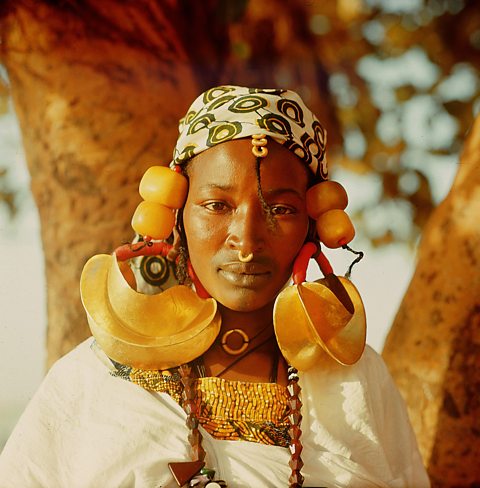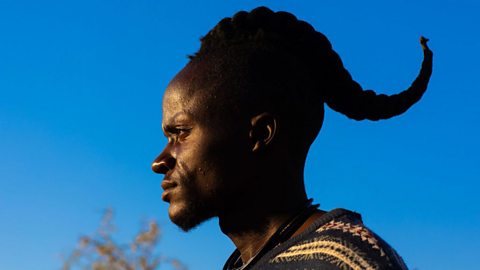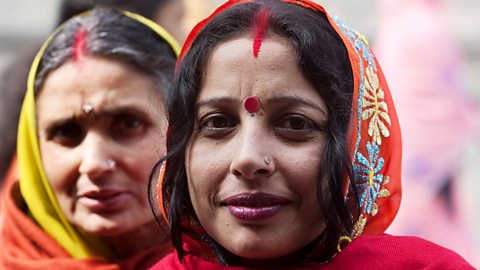Humans have always used their clothing, hairstyles and jewellery as a way of quickly telling people important information about themselves, including whether or not they are married.
Choosing whether to show the world your marital status is a personal preference that can be made for a variety of reasons, from wanting to display love for a spouse, to preventing unwanted attention.
From the choice of finger for a wedding ring to styling your hair a particular way, cultures and communities across the world all have different ways of signalling whether someone is married.
 Image source, Werner Forman
Image source, Werner FormanJewellery
In Western cultures, the wearing of wedding rings has become a common sight over the past few centuries. However, not everybody chooses to wear their wedding ring on the same hand or finger. Nor is it always the same finger as an engagement ring.
In the UK, wedding rings are mostly commonly wore on the ring finger of the left hand and this is a popular choice worldwide. Some LGBTQ+ couples choose to wear their wedding rings on the right hand.
It is tradition within Orthodox Churches for married couples to wear their rings on the right hand. During the religious service, the priest will place the groomâs ring on the brideâs right hand, and vice versa. The best man, known as the koumbaro, will then switch the rings from hand to hand three times, so that they end up in the right place.
The right hand is chosen over the left because of the importance placed on the right hand within religious teachings. For example, Christ is said to be seated at the right hand of the Father.
In Sri Lanka, where there are strong Sinhalese and Tamil cultural influences, the groom will typically wear his wedding ring on his right hand, whilst the bride will wear hers on the left. Meanwhile, in Brazil, when a couple get engaged they will both wear a ring on the ring finger on the right hand. During the wedding ceremony, these rings are then moved to the left hand.
Itâs not just on their hands that married women might wear a ring, however. In India, a pair of rings known as âbichiyaâ may be worn on the second toe of each foot. Traditionally, these rings cannot be made of gold, as gold is only worn above the waist in Hindu culture. Instead, they are typically made of silver and may be presented as part of the wedding ceremony.
 Image source, Werner Forman
Image source, Werner FormanHair
Sporting a certain hairstyle or covering your hair in a particular way, can be another way of signalling to others if youâre married.
Unmarried Amish men remain clean-shaven until marriage, so if you see a member of this religious community with a full beard, you can be pretty certain that theyâre married.
Prior to marriage, the Himba men of northwest Namibia will signal their single status by wearing their hair in a long single plait known as an âondatoâ, or two plaits, known as âozondatoâ. Once married, they will cover their hair with turban which is then never removed, unless the man becomes a widow.
Himba women style their hair in dreadlocks covered in otjize paste, a mix of butterfat and a red ochre pigment. The bold red colour symbolises the earth and blood, essential for life. A headdress made from sheep or goat skin, known as an erembe, is then added following a year of marriage or the birth of a womanâs first child.
 Image source, Eric Lafforgue
Image source, Eric LafforgueMany Orthodox or Hasidic Jewish women make the choice to cover all or part of their hair following marriage, either with a scarf (called a tichel), hat or wig (known as a sheitel). This may be done all the time, when out of the home or just when praying in the synagogue, when in the presence of men who are neither their husband or a close relative.
The practice has its roots in ancient Jewish modesty rules, but they remain popular today as a way of enabling married Jewish women to display their identity whilst still covering their natural hair. Some Hasidic women will shave their head entirely.
 Image source, IndiaPictures
Image source, IndiaPicturesAs part of the Hindu wedding ceremony, the groom will apply a red powder known as âsindoorâ, to the brideâs hair parting. Afterwards, the married woman may choose to continue to apply the mark everyday, unless she becomes a widow. In the Ramayana, a Hindu epic poem which tells the stories of the deities Rana and Sita, it is said that Sita applied sindoor.
This article was published in August 2022.
Four surprising things you didnât know about accents
±«Óătv Bitesize looks at four interesting factors that can influence the way we speak.

Eight feel-good words from around the world to give you instant summer vibes
From a leisurely chat after a meal to the time off given to enjoy a sunny day, here are some expressions that will make you smile.

Coronations from around the world
The traditions and rituals when monarchs take their throne.
